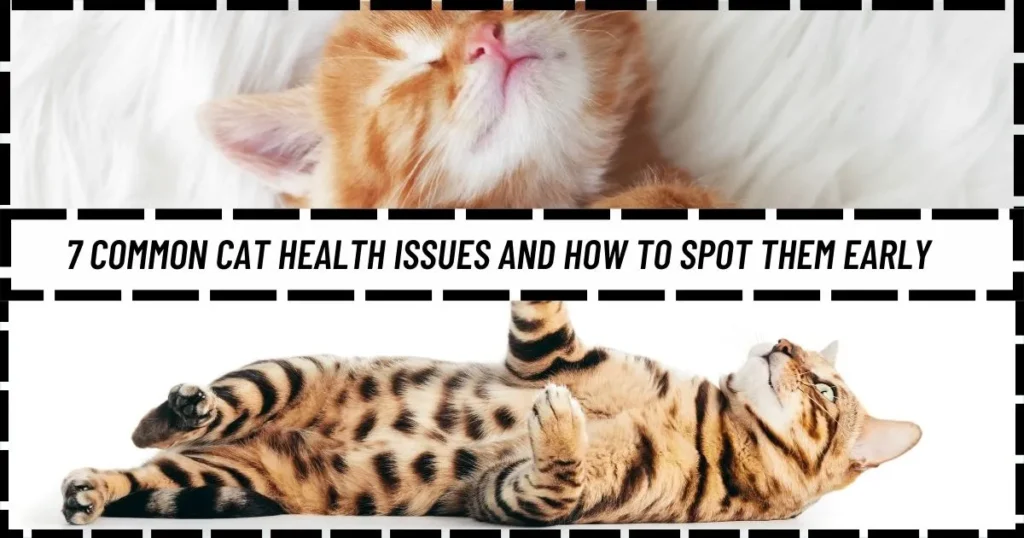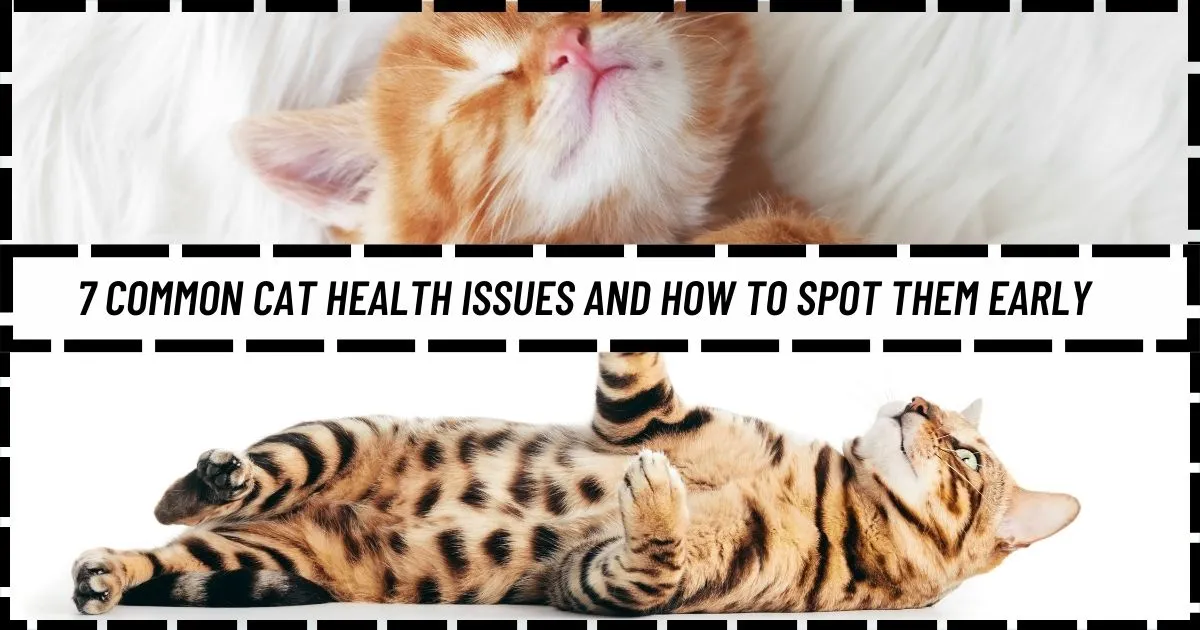7 Common Cat Health Issues and How to Spot Them Early
Your Cat Can’t Speak But Their Body Can
Your cat might be the most independent member of your household, but that doesn’t mean they don’t need your help when it comes to their health. Unlike humans, cats can’t simply tell you when they’re in pain or feeling off. Their instincts drive them to mask symptoms especially when they’re not feeling their best. This silent suffering is why many cat health issues go undetected until they’ve progressed into something more serious.
As a devoted cat parent, understanding the most common feline health issues and how to spot early signs can make a massive difference in your cat’s life. Whether you’ve recently welcomed a kitten into your home or you’re navigating the golden years of your senior cat, this guide is your go-to resource for identifying and managing the most frequent feline illnesses.
Table of Contents
1. Dental Disease
Dental disease is one of the most widespread yet overlooked health concerns in cats. It can affect not only their mouth but also their internal organs due to bacteria entering the bloodstream.
Symptoms:
- Bad breath that doesn’t go away
- Drooling excessively
- Trouble eating dry food or favoring one side of the mouth
- Red or bleeding gums
- Pawing at the mouth or face
- Visible tartar or discolored teeth
What to Do:
- Brush your cat’s teeth with a cat-safe toothbrush and paste
- Schedule annual dental checkups
- Offer dental treats and toys to reduce tartar
- Consider professional cleanings under anesthesia if recommended by your vet
If left untreated, dental issues can lead to painful infections and tooth loss, making preventative care essential.
2. Obesity
Obesity is more than just a few extra pounds it’s a chronic condition that can severely impact your cat’s health, leading to complications like diabetes, heart disease, and joint pain.
Symptoms:
- Difficulty jumping or playing
- Low activity levels
- Inability to groom themselves properly
- Obvious fat accumulation around the abdomen or ribs
What to Do:
- Transition to portion-controlled feeding
- Use feeding puzzles to slow down fast eaters
- Engage in daily play sessions with feather wands or laser pointers
- Ask your vet about prescription diets or weight-loss strategies
Maintaining a healthy weight adds years to your cat’s life and improves their overall well-being.
3. Urinary Tract Issues
Urinary tract issues, particularly Feline Lower Urinary Tract Disease (FLUTD), are common in both male and female cats. These conditions are not only painful but can also become life-threatening if left untreated.
Symptoms:
- Straining to urinate or crying out in pain
- Frequent trips to the litter box with little or no urine output
- Blood-tinged urine
- Urinating outside the litter box
- Excessive grooming of the genital area
What to Do:
- Increase water intake with wet food or a pet fountain
- Reduce stress with consistent routines and calming diffusers
- Keep litter boxes clean and in quiet, accessible areas
- Immediate veterinary care is necessary for blocked cats
Male cats are especially at risk for urinary blockages, which can become fatal within hours, so urgent action is crucial.
4. Parasites
From fleas and ticks to intestinal worms, parasites can affect cats of any age even those who live strictly indoors. Not only do they cause discomfort, but some can also transmit diseases.
Symptoms:
- Persistent scratching or biting of the skin
- Scooting or dragging the rear on the floor
- Visible worms in stool or around the anus
- Dull coat and poor overall appearance
What to Do:
- Use monthly preventative treatments recommended by your vet
- Wash bedding regularly and vacuum carpets
- Deworm your cat on a schedule, especially if they hunt or go outdoors
- Schedule fecal exams during annual vet visits
Preventing parasites not only protects your cat but also helps reduce the risk of transmission to humans and other pets.
5. Kidney Disease
Chronic kidney disease (CKD) is a leading cause of illness and death in older cats. While it’s not curable, early management can slow its progression.
Symptoms:
- Drinking more water than usual
- Frequent or increased urination
- Nausea, vomiting, or loss of appetite
- Weight loss and muscle wasting
- Bad breath with a chemical smell
What to Do:
- Monitor water consumption and litter box output
- Switch to a kidney-friendly diet with low phosphorus and protein
- Administer fluids at home if advised by your vet
- Schedule regular blood and urine tests for early detection
With attentive care, cats with kidney disease can live comfortably for years.
6. Hyperthyroidism
Hyperthyroidism affects the thyroid gland, causing it to produce excess hormones. It’s most commonly seen in cats over the age of 10.
Symptoms:
- Noticeable weight loss despite increased appetite
- Hyperactivity and restlessness
- Vomiting and diarrhea
- Increased thirst and urination
- Rapid heart rate or high blood pressure
What to Do:
- Schedule blood tests to check thyroid hormone levels
- Consider treatments such as daily medication, radioactive iodine therapy, or surgery
- Regular monitoring is essential to adjust treatment and catch related issues
Hyperthyroidism is manageable with early diagnosis and a personalized treatment plan.
7. Upper Respiratory Infections
These are particularly common in kittens or cats from shelters and multi-pet households. They are usually caused by viruses like feline herpesvirus or calicivirus.
Symptoms:
- Sneezing and coughing
- Nasal discharge or runny eyes
- Congestion leading to difficulty eating or breathing
- Lethargy and loss of appetite
What to Do:
- Isolate infected cats to prevent spreading
- Use a humidifier to ease breathing
- Keep your cat warm and hydrated
- Seek veterinary care if symptoms worsen or persist
Vaccination and good hygiene are the best ways to prevent these illnesses.

Table: Quick Reference Guide to Cat Health Issues
| Health Issue | Key Symptoms | Prevention/Treatment |
|---|---|---|
| Dental Disease | Bad breath, drooling, tooth discoloration | Brushing, dental treats, vet cleanings |
| Obesity | Inactivity, weight gain, difficulty grooming | Portion control, active play |
| Urinary Tract Issues | Painful urination, blood in urine | Hydration, vet care |
| Parasites | Scratching, worms, hair loss | Preventives, hygiene |
| Kidney Disease | Excessive thirst, vomiting | Early testing, kidney diet |
| Hyperthyroidism | Weight loss, high appetite | Medication, therapy |
| Respiratory Infections | Sneezing, nasal/eye discharge | Vaccination, vet care |
FAQs
How can I tell if my cat is sick or just having an off day?
If your cat skips a meal or seems sleepy for a few hours, it may not be a big deal. But if you notice changes in appetite, behavior, grooming, or litter box use that last longer than a day, it’s time to call the vet.
When should I start senior wellness checks for my cat?
Most vets recommend annual senior bloodwork and exams starting around age 7. These checkups can detect age-related conditions like kidney disease or hyperthyroidism before symptoms become visible.
Is it safe to treat fleas or worms at home?
Only with products specifically recommended by your vet. Over-the-counter treatments can sometimes do more harm than good, especially if they contain harsh chemicals.
Can indoor cats really get sick from parasites or infections?
Yes! Parasites can be brought in on clothing or other pets, and airborne viruses spread easily between cats. Even indoor kitties benefit from routine vet care and preventive treatments.
Final Thoughts: Be Your Cat’s Health Advocate
Your furry friend might not speak your language, but they count on you to interpret their signals. The earlier you catch health problems, the more options you have for effective treatment and the better your cat’s quality of life will be.
Be proactive with routine vet visits, a balanced diet, daily play, and lots of affection. Prevention, observation, and education are the best tools in your feline care toolkit.



